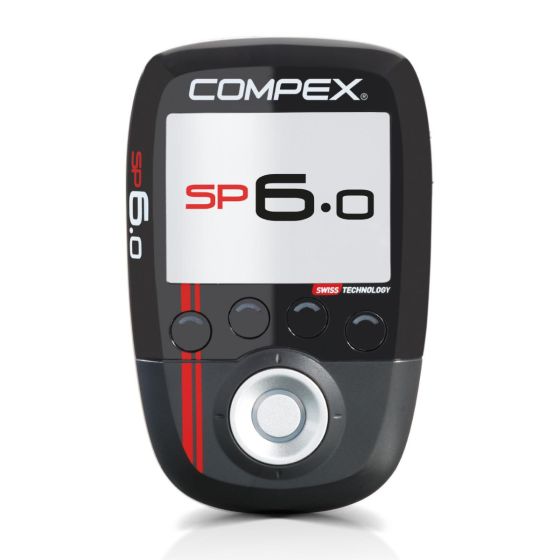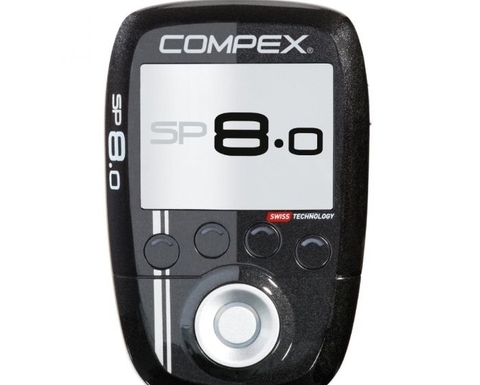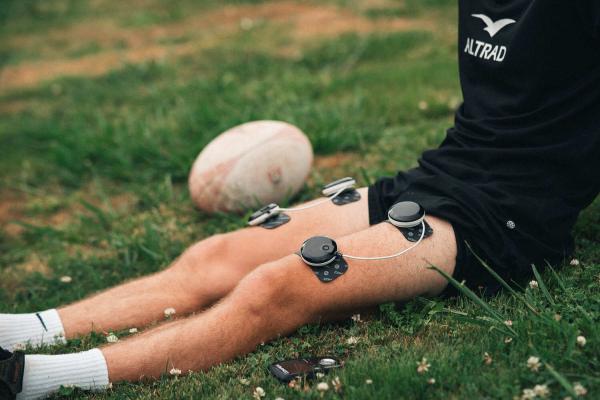Muscle Stimulator to Maximise your Results
Compex SP 6.0
Improves your strength and restores muscle volume, helps you relax and recover faster.
Designed for athletes who practice their activity more than 3 times per week, SP 6.0 includes all the features of SP 4.0, but with wireless features that ensure total freedom of movement. Its easy-to-use color screen even shows you where to place the electrodes!
This product is covered by our Compex 2 year warranty. Register your product here to receive 1 extra year.
MI, PERSONALIZED STIMULATION
ADAPTED FOR EVERY PHYSIOLOGY
Equipped with unique MI (muscle intelligence) technology, Compex stimulators adapt to each of your muscles to provide the most effective muscle stimulation possible, while offering greater comfort and better performance
Boost your performance*

*Learn more about our scientific studies.
MI, HOW IT WORKS
MI-SCAN
scans the muscle and automatically adjusts stimulator parameters to your physiology.
MI-RANGE
Indicates the optimal level of stimulation to use for Recovery and Massage programs.
COMPEX SP 6.0
Categories and programmes
Conditioning
Endurance, Resistance, Strength, Explosive strength, Cross training, Core stabilisation, Hypertrophy, Muscle building, Potentiation, Warm-up, Capillarisation
Recovery/Massage
Training recovery, Competition recovery, Relaxing massage, Reduce muscle soreness, Reviving massage
Pain management
Pain management TENS, Reduce muscle tension, Muscle pain, Neck pain, Back pain, Tendinitis, Heavy legs, Cramp prevention
Rehabilitation
Muscle atrophy, Reinforcement
Fitness
Firm your arms, Tone your thighs, Get a 6-pack, Firm your stomach, Shape your buttocks
Testimonials
CUSTOMER TESTIMONIALS
See what our users think of us
Product Questions
- Remote control
- 4 modules
- Loading station
- Charger
- 4 Snap electrodes 5x10 cm (double clip)
- 8 Snap electrodes 5x5 cm (single clip)
- 4 Snap electrodes 5x10 cm (single clip)
- Transport case
- USB wire
- Instruction manual
| Technology: | Wireless |
|---|---|
| Muscle intelligence: | MI-scan, MI-range on the 4 modules |
| Web connection: | Yes |
| Download objective: | No |
| Upload remote history: | Yes |
| Program categories: | Fitness, Pain management, Recovery / Massage, Rehabilitation |
| NB of programs: | 30 |
| NB of channels: | 4 |
| Screen | Matrix colors: |
| Power: | 120 mA, 400 us, 150 Hz |
| Energy: | Rechargeable battery in less than 2h |
Instructions for Use
How To Use for Training
Select which exercise you wish to perform and select the conditioning program that suits your training objectives. Check the device for the correct electrode placement for the muscle you are training and get training!
For more information on Static & Dynamic exercises please visit our Compex Training page:
How to use (FAQ)
- Body position during stimulation
-
This position varies according to the muscle group that you wish to stimulate and the programme that you are using.
For programmes inducing powerful muscular contractions (tetanic contractions), it is recommended to stimulate the muscle isometrically. You should therefore hold the extremities of limbs being stimulated. This position opposes maximum resistance to movement and avoids any shortening of the muscle during contraction, which would risk causing cramps. For example, when stimulating the quadriceps, you should be in a sitting position with ankles held to avoid extending the knees.
For the other types of programmes which do not induce powerful muscular contractions but only muscular twitches or tingling, position yourself as shown on the illustration, maintaining a comfortable position.
- Adjusting stimulation intensities
-
On a stimulated muscle, the number of fibres used depends on the stimulation intensity.
For programmes inducing powerful muscular contractions (tetanic contractions), you must use the maximum stimulation intensities (up to 999) while remaining within your tolerance threshold, in order to
use the maximum number of fibres. The progress of a muscle will be greater the higher number of fibres that are worked. During a session it is therefore important to try to increase the intensity every 3 to 5 contractions.
For other types of programmes like recovery, massage, capillarisation or even muscle pain which only induce muscle twitches, you should gradually increase the stimulation intensities until clearly visible muscle twitches are obtained.
For TENS, Epicondylitis and Tendinitis programmes, you should gradually increase the intensities until you feel a tingling sensation under the electrodes. - Scheduling of the stimulation sessions.
-
The question of the scheduling of the stimulation sessions during the week only arises in situations where at least two training sessions are to be done in the same week.
In cases where up to six sessions a week are planned, it is recommended that the sessions be scheduled as far apart as possible. For example, anyone who does three sessions a week should do them at the rate of one session every two days (2x1 rest day and 1x2 days of rest/week). Anyone who does six sessions should do six consecutive days of stimulation with one day of rest.
Above seven sessions a week, it is advisable to group several sessions together on the same day to leave yourself one or two complete rest days without stimulation. Anyone who does seven sessions a week should do five days of stimulation, at the rate of one session per day with one two-session day(s) (with at least a half-hour's rest between the sessions), leaving one rest day. Anyone who does ten sessions a week should preferably do five two-session days (again with at least a half-hour's rest between the sessions), leaving two rest days.
- Alternation of stimulation sessions/voluntary training
-
The stimulation sessions can be done outside of or during voluntary training.
When voluntary training and stimulation are done during the same session, it is generally recommended that the voluntary training be done first followed by the stimulation. This means that the voluntary training is not done on muscle fibres which are already tired. This is particularly important for strength and explosive strength training.
However, in resistance training, it can be very useful to proceed in the reverse order. Before the voluntary training, by means of stimulation for resistance, a “specific pre-fatigue session” is carried out on the muscle fibres without general and cardio-vascular fatigue. In this way, the voluntary effort on the “prepared” fibres will push the glycolytic metabolism faster and further.
- Progression of stimulation cycles
-
The stimulation cycles are for people who are already accustomed to electrostimulation and want to perform several training cycles.
The cycle logic refers to the workload performed by electrostimulation. Just like a normal workout, one has to to start with an amount of effort then increase it over the course of the cycles. Thus, it is recommended starting with the 1st cycle and going on to the next level when the cycle is finished, normally after 4 to 6 weeks of stimulation based on 3 sessions per week.
It is also important to have reached significant stimulation intensities in sessions before going on to another cycle. At the end of a cycle you can either start a new cycle or do maintenance training based on one session per week.



